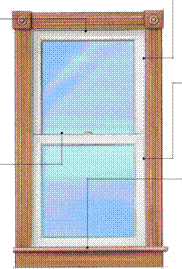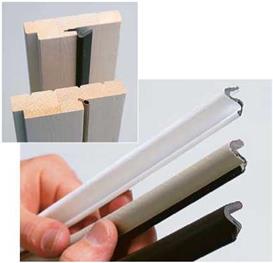Tapes
These inexpensive tapes come in several varieties: nonporous, closed-cell foam; open-cell foam silicone; and various rubbers, including a product called EPDM (ethylene propylene diene monomer). It’s worth spending a few extra cents per foot to buy the more-efficient closed-cell foam or higher-quality silicones. Any of these styles can be purchased in various thicknesses and lengths.
Although installation is easy—little more than peel-and-stick—be sure to clean surfaces using a mild detergent prior to setting the tape in place. In areas that see little use, such as inoperable windows, expect the tape to last roughly three years. On frequently opened windows, you’ll need to replace it in as little as a year. Securing the tape with tacks or staples helps to extend its longevity. As a general rule, apply this type of weatherstripping only on parts of windows that are not opened, such as around the upper sash.
Durability: Poor Cost: Vinyl foam: about 20ФДк X-Treme Rubber: about ЗОФ/ft. Rubber foam: about ЗОФ/ft. EPDM rubber: about 80ФДк Silicone: about $1.15/ft.

 |
|
|
|
||
|
||
|
||
|
||
|
||


 Cut the groove toward the corners. Plunge the kerfing tool into the seam between the window jamb and the stop that holds the sash, and move it slowly toward the top and bottom corners of the jamb. A vacuum hose sucks up stray sawdust. silicone-bead and other kerf – in weatherstripping is easy to install. Just cut the corners at a 45-degree angle, and press the flat fin into the kerf.
Cut the groove toward the corners. Plunge the kerfing tool into the seam between the window jamb and the stop that holds the sash, and move it slowly toward the top and bottom corners of the jamb. A vacuum hose sucks up stray sawdust. silicone-bead and other kerf – in weatherstripping is easy to install. Just cut the corners at a 45-degree angle, and press the flat fin into the kerf.


![]()

Durability: silicone: excellent Plastic polymer and foam: good Cost: Plastic polymer: about 18$/ft. Foam: about 38$/ft.
Silicone: 35$/ft. to $1.10/ft.
A kerf is a blade-width notch cut into a door or window jamb with a saw or router. New doors often come with kerf-in weatherstripping in place. Although silicone might last up to 50 years, plastic and foam kerf-in weatherstripping might need replacement sooner. Simply pull out the old weatherstripping and snap the new, self-locking product into place.
Although it’s possible to install kerf – in weatherstripping on old windows not originally designed for it, you need to rent a corner-grooving tool (see the photos above left and on p. 87) to create the kerf. If you’re tool savvy, these router-like machines are easy to use. Expect to pay about $70 per day for the rental.







Leave a reply